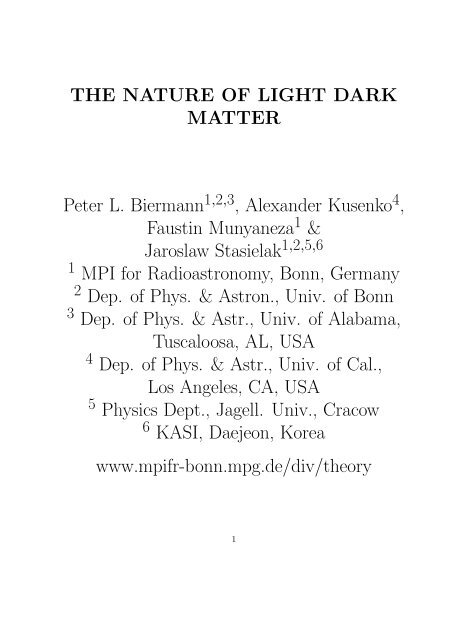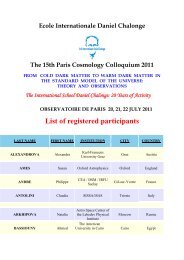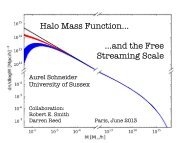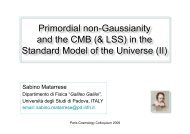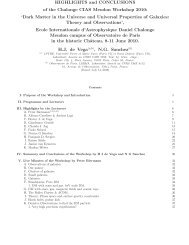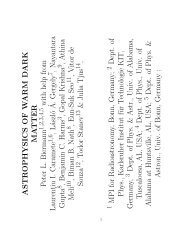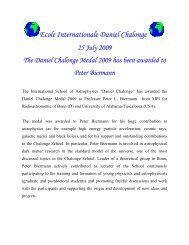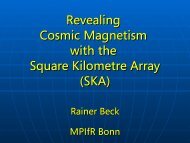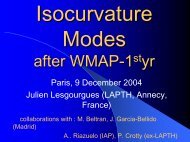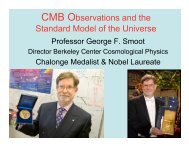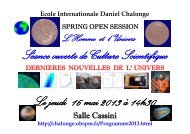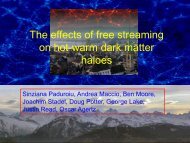THE NATURE OF LIGHT DARK MATTER Peter L. Biermann ...
THE NATURE OF LIGHT DARK MATTER Peter L. Biermann ...
THE NATURE OF LIGHT DARK MATTER Peter L. Biermann ...
Create successful ePaper yourself
Turn your PDF publications into a flip-book with our unique Google optimized e-Paper software.
<strong>THE</strong> <strong>NATURE</strong> <strong>OF</strong> <strong>LIGHT</strong> <strong>DARK</strong><br />
<strong>MATTER</strong><br />
<strong>Peter</strong> L. <strong>Biermann</strong> 1,2,3 , Alexander Kusenko 4 ,<br />
Faustin Munyaneza 1 &<br />
Jaroslaw Stasielak 1,2,5,6<br />
1 MPI for Radioastronomy, Bonn, Germany<br />
2 Dep. of Phys. & Astron., Univ. of Bonn<br />
3 Dep. of Phys. & Astr., Univ. of Alabama,<br />
Tuscaloosa, AL, USA<br />
4 Dep. of Phys. & Astr., Univ. of Cal.,<br />
Los Angeles, CA, USA<br />
5 Physics Dept., Jagell. Univ., Cracow<br />
6 KASI, Daejeon, Korea<br />
www.mpifr-bonn.mpg.de/div/theory<br />
1
Dark Matter: The evidence<br />
• Dark Matter is required:<br />
• for stability of disks in galaxies<br />
(e.g. Ostriker)<br />
• to explain the rotation curves (e.g. Rubin)<br />
• to explain the hot gas distribution in early<br />
Hubble type galaxies (e.g. <strong>Biermann</strong>)<br />
• to explain the motions in groups and clusters<br />
(e.g. Zwicky)<br />
• to explain the hot gas containment in groups<br />
and clusters (e.g. Ensslin et al.)<br />
• to explain the structure formation<br />
• to explain the flat geometry of the Universe<br />
(Spergel et al. 2003, 2007)<br />
70 years: What is dark matter?<br />
2
Dark Matter: Some history<br />
Sterile neutrinos? Weakly interacting neutrinos<br />
- interact with other neutrinos and gravity<br />
• 1930ies: ”Dark Matter” first: Oort (1932),<br />
Zwicky (1933, 1937), and Swift (1936)<br />
• 1970: Pontecorvo considers sterile neutrinos<br />
and introduces the name<br />
• 1982: Olive & Turner consider sterile neutrinos<br />
in general terms<br />
• 1994: Dodelson & Widrow show that sterile<br />
neutrinos can be dark matter<br />
• 1997: Kusenko & Segre show that sterile<br />
neutrinos can explain pulsar kicks<br />
• 2006: Shaposhnikov: The various origins of<br />
sterile neutrinos<br />
3
Proposal<br />
• Lightest supersymmetric particle, very massive:<br />
problem small scales<br />
• However: G. Gilmore et al find many small<br />
dwarf galaxies, and<br />
smaller satellites are hindered in formation<br />
by ionization<br />
• Sterile neutrinos at 2 keV < ∼ m DM < ∼ 20 keV.<br />
• Right handed neutrinos, very weakly interact<br />
with normal left handed neutrinos; otherwise<br />
interact only via gravitation<br />
• Lifetime τ = 1.3 10 26 s<br />
⎛<br />
⎜<br />
⎝ 7keV<br />
m DMc 2<br />
⎞<br />
⎟<br />
⎠<br />
5 ⎛<br />
⎜<br />
⎝<br />
0.8 10−9<br />
sin2 ⎞<br />
⎟ ⎠.<br />
θ<br />
• They decay, most importantly: one active<br />
neutrino and a photon<br />
• Never in thermodynamic equilibrium, require<br />
a chemical potential; probably far subthermal<br />
4
Background<br />
• They can be produced in the right amount<br />
(Dodelson & Widrow 1994; Shi & Fuller<br />
1999; Abazijian et al. 2001; Dolgov &<br />
Hansen 2002; Abazajian 2006)<br />
• They can explain the baryon asymmetry<br />
(Akhmedov et al. 1998; Asaka & Shaposhnikov<br />
2005)<br />
• They can explain the lack of power on small<br />
scales in Large Scale Structure Formation<br />
(Olive & Turner 1982; Abazajian 2006)<br />
• They can explain the inner dark matter distribution<br />
and spatial shape in galaxies Belokurov<br />
et al. 2006; Fellhauer et al. 2006)<br />
Lots of recent work by Kevork Abazajian<br />
and Mikhail Shaposhnikov<br />
5
Our recent work<br />
• Pulsar kicks, velocities up to 1000 km/s –<br />
see the guitar nebula – (Kusenko 2004)<br />
range: 2 to 20 keV<br />
• ! Transition from active neutrino to weakly<br />
interacting neutrino to prevent scattering:<br />
right handed neutrino!<br />
• Early growth of black holes (Munyaneza &<br />
<strong>Biermann</strong> 2005)<br />
range: 12 - 450 keV: ! Fermion<br />
• Aspen September 2005: Overlap - Eureka!<br />
• From increased secondary ionization<br />
molecular Hydrogen formed more abundantly,<br />
and so star formation triggered early (<strong>Biermann</strong><br />
& Kusenko 2007; Stasielak, <strong>Biermann</strong><br />
& Kusenko 2006) – this removed major obstacle<br />
(Yoshida et al. 2003) for this known<br />
proposal<br />
6
First star formation<br />
• Sterile neutrinos decay into an active neutrino<br />
and a photon (of half the mass in energy)<br />
• After redshift about 40 no absorption anymore,<br />
before fraction of ionized atoms (η<br />
fraction of photon energy into ionization)<br />
x (s)<br />
e ∼ 0.2<br />
(1+z)<br />
0.3<br />
3/2 ( η<br />
• Formation of H2 via H −<br />
) ( ms<br />
7 keV )5 ( sin2 θ<br />
0.8 10 −9)<br />
• Level of H2 above 5 10 −4 (Tegmark et al.<br />
1997) strong cooling<br />
• Almost an order of magnitude enhancement,<br />
with maximum at redshift 80<br />
• Corresponding heating cancels effect for redshifts<br />
< 20 (Mapelli, Ripamonti 2006)<br />
7
The first stars<br />
• Star formation triggered early<br />
• Early magnetic fields from first massive stars<br />
– the fastest process – then cosmic ray driven<br />
dynamo process in galactic disks, implies by<br />
necessity galactic winds<br />
• Reionization from first massive stars at<br />
z > 10<br />
• Energy input from stellar winds and supernovae<br />
• Chemical enrichment from first massive stars<br />
(Wolf Rayet star winds and supernovae)<br />
• First dust<br />
• First Gamma Ray Bursts<br />
• First stellar black holes<br />
• First cosmic rays<br />
8
Primordial magnetic fields<br />
• Ionization by secondary electron, from ionization:<br />
• The time scale for energy gain<br />
(e.g., Jokipii 2004)<br />
τ A = 4κ<br />
V 2 A<br />
(1)<br />
• Assuming B2 /8π<br />
I(k)k 1 and I(k) ∼ k−1<br />
to just cancel the energy loss by ionization<br />
B(z = 100) < 2 10−8 Gauß, corresponding<br />
to today<br />
B < 4 10 −12 Gauß. (2)<br />
• K. Dolag et al. (2002, 2005):<br />
B < (0.2 − 1.) × 10 −12 Gauß from structure<br />
formation simulations: consistent !<br />
9
Galaxies<br />
• Galaxies merge, and then<br />
• Energy transported out, matter transported<br />
in, due to extreme mixing in a merger; akin<br />
to accretion disk theory (Lüst 1952)<br />
• Inner dark matter distribution: Powerlaw,<br />
Moore 1998, Klypin et al. 2002, Navarro,<br />
Frenk, & White 1997<br />
• Consider the low momentum tail of phase<br />
space distribution; for keV Fermions degenerate<br />
configuration: <strong>DARK</strong> <strong>MATTER</strong><br />
STAR<br />
• Suggestion, that Galactic Center Black Hole<br />
possibly only fed from dark accretion<br />
• Alternative: direct collapse from supermassive<br />
star, or very compact stellar cluster:<br />
about 10 6 M⊙<br />
10
X-ray background<br />
• 2005 - 2007: Boyarsky et al., Riemer-Sørensen,<br />
Watson, ...<br />
• What is the upper limit to an invisible emission<br />
line at an energy m DMc 2 /2<br />
• X-ray background: if dark matter, then<br />
m DM < 10 keV<br />
• Neighboring clusters of galaxies (Virgo, Coma)<br />
• Neighboring galaxies (M31)<br />
• With major effort may be positively detectable<br />
with the X-ray satellites Chandra<br />
and Newton: Large field high spectral resolution<br />
spectroscopy<br />
• Neighboring dwarf ellipticals: Suzaku observations:<br />
M. Loewenstein, Kusenko, PLB<br />
11
Lyman-α forest<br />
• McDonald et al. 2001: forest example; simulations,<br />
weak fluctuations in density<br />
• Seljak et al. 2006: WDM power spectrum<br />
versus CDM power spectrum<br />
• McDonald et al. 2000: Contamination by<br />
metal lines?<br />
• Seljak et al. 2006: SDSS data and high resolution<br />
data versus models in CDM (thick<br />
lines) and WDM (thin lines)<br />
• Seljak et al. 2006: Discrepancy at high redshift:<br />
m DM > 14 keV<br />
• Viel et al. 2006: same analysis m DM > 10<br />
keV<br />
• Reconciliation with lower mass by subthermal<br />
property of particle?<br />
12
Galaxies<br />
Work of group around G. Gilmore<br />
• Shape of our Galaxy halo: Very spherical:<br />
From precessional disruption of incoming<br />
dwarf galaxies<br />
• Mass of dwarf spheroidal galaxies<br />
• All data consistent with lower limit to dark<br />
matter mass of 5 10 7 M⊙, for a large range<br />
of baryonic mass - direct indication for warm<br />
dark matter (or formation history? effect of<br />
ionization, heating and cooling of satellite<br />
galaxy?)<br />
• Based on Gilmore et al. (2007), and Wyse<br />
& Gilmore (2007):<br />
m DM < 4 keV (AK)<br />
13
Summary<br />
• Right-handed neutrinos? far subthermal?<br />
• First star formation; first reionization; first<br />
magnetic fields; first cosmic rays; first black<br />
holes; first ultra high energy cosmic rays<br />
• X-ray line from galaxies, and background<br />
• Pulsar kicks<br />
• Lyman α-forest - consistent for subthermal<br />
distribution<br />
• Galactic halo structure; dwarf spheroidal<br />
galaxies<br />
• All of these findings can be explained independently.<br />
If one concept: sterile neutrino<br />
• ∼ 2 keV < ∼ ms < ∼ ∼ 4 keV<br />
• Critical test X-ray emission line<br />
Weakly Interacting Neutrinos<br />
14
Acknowledgements<br />
Support for PLB is coming from the AUGER<br />
membership and theory grant 05 CU 5PD 1/2<br />
via DESY/BMBF. Support for AK is coming<br />
from DOE grant DE-FG03-91ER40662 and NASA<br />
ATP grants NAG 5-10842 and NAG 5-13399.<br />
Support for FM is coming from the Humboldt<br />
Foundation.<br />
References<br />
[1] “Observed properties of dark matter on<br />
small spatial scales”, Wyse, & Gilmore<br />
(2007); arXiv/0708.1492<br />
[2] “The observed properties of dark matter<br />
on small scales”, Gilmore et al. (2007);<br />
astro-ph/0703308<br />
15
[3] “Constraints on Sterile Neutrino Dark<br />
Matter”, Abazajian, K., Koushiappas, S.<br />
M., Phys. Rev. D (submitted, 2006),<br />
astro-ph/0605271<br />
[4] “ Linear cosmological structure limits<br />
on warm dark matter”, Abazajian, K.,<br />
Phys. Rev. D 73, id. 063513 (2006),<br />
astro-ph/0512631<br />
[5] “Production and evolution of perturbations<br />
of sterile neutrino dark matter”,<br />
Abazajian, K., Phys. Rev. D 73, id.<br />
063506 (2006), astro-ph/0511630<br />
[6] “Cosmological lepton asymmetry, primordial<br />
nucleosynthesis and sterile neutrinos”,<br />
Abazajian, K., Phys. Rev. D<br />
72, id. 063004 (2005)<br />
[7] “Sterile neutrino hot, warm, and cold<br />
dark matter”, Abazajian, K., Fuller, G.<br />
16
M., Patel, M., Phys. Rev. D 64, id.<br />
023501 (2001)<br />
[8] “Baryogenesis via Neutrino Oscillations”,<br />
Akhmedov, E. Kh., Rubakov, V.<br />
A., Smirnov, A. Yu., Phys. Rev. Letters<br />
81, 1359-1362 (1998)<br />
[9] “The νMSM, dark matter and baryon<br />
asymmetry of the universe, Asaka, T.,<br />
Shaposhnikov, M., Phys. of Fluids 620,<br />
17-26 (2005)<br />
[10] “Opening a new window for warm dark<br />
matter”, Asaka, T., Shaposhnikov, M.,<br />
Kusenko, A., Phys. of Fluids 638, 401-<br />
406 (2006), hep-ph/ 0602150<br />
[11] “The νMSM, dark matter and neutrino<br />
masses”, Asaka, T., Blanchet, St., Shaposhnikov,<br />
M., Phys. of Fluids 631,<br />
151-156 (2005)<br />
17
[12] “The Field of Streams: Sagittarius and<br />
Its Siblings”, Belokurov, V. et al., Astrophys.<br />
J. Letters 642, L137 - L140<br />
(2006), astro-ph/0605025)<br />
[13] “The detection of hot intergalactic gas in<br />
the NGC 3607 group of galaxies with the<br />
Einstein satellite”, <strong>Biermann</strong>, P., Kronberg,<br />
P. P.; Madore, B. F., Astrophys.<br />
J. Letters 256, p. L37-L40 (1982)<br />
[14] “Detection of 10 to the 10th solar masses<br />
of hot gas in the normal elliptical galaxy<br />
NGC 5846 with the Einstein satellite”,<br />
<strong>Biermann</strong>, P., Kronberg, P. P., Astrophys.<br />
J. Letters 268, p. L69-L73 (1983)<br />
[15] “Relic keV sterile neutrinos and reionization”,<br />
P.L. <strong>Biermann</strong> & A. Kusenko,<br />
2006, Phys. Rev. Letters 96, 091301<br />
(2006); astro-ph/0601004<br />
18
[16] “Ultra high energy cosmic rays from sequestered<br />
X bursts [rapid communication]”,<br />
P.L. <strong>Biermann</strong> & P. Frampton<br />
2006, Physics Letters B, 634, p. 125-<br />
129 (2006); astro-h/0512188<br />
[17] “Cosmic-ray protons and magnetic fields<br />
in clusters of galaxies and their cosmological<br />
consequences”, Torsten A. Enßlin,<br />
<strong>Peter</strong> L. <strong>Biermann</strong>, Philipp P. Kronberg,<br />
and Xiang P. Wu, Astrophys. J. 477,<br />
560 (1997); astro-ph/9609190<br />
[18] “Where to find a dark matter sterile<br />
neutrino?”, Boyarsky, A., Neronov,<br />
A., Ruchayskiy, O., Shaposhnikov, M.,<br />
Tkachev, I., astro-ph/0603660<br />
[19] “Restrictions on parameters of sterile<br />
neutrino dark matter from observations<br />
of galaxy clusters”, Boyarsky, A.,<br />
19
Neronov, A., Ruchayskiy, O., Shaposhnikov,<br />
M., astro-ph/0603368<br />
[20] “Constraints on sterile neutrino as dark<br />
matter candidate from the diffuse Xray<br />
background”, A. Boyarsky, A.<br />
Neronov, O. Ruchayskiy, M. Shaposhnikov,<br />
Month. Not. Roy. Astr. Soc. in<br />
press, July 2006, astro-ph/0512509<br />
[21] “Sterile neutrinos as dark matter”, Dodelson,<br />
S., Widrow, L. M., Phys. Rev.<br />
Letters 72, 17-20 (1994)<br />
[22] “Massive sterile neutrinos as warm dark<br />
matter”, Dolgov, A. D., Hansen, S. H.,<br />
Astropart. Phys. 16, 339-344 (2002)<br />
[23] “The Origin of the Bifurcation in the<br />
Sagittarius Stream”, Fellhauer, M., et<br />
al., (2006), astro-ph/0605026<br />
[24] Kusenko & Segre (1997)<br />
20
[25] “Pulsar kicks from neutrino oscillations,”A.<br />
Kusenko, Int. J. Mod. Phys. D<br />
13, 2065 (2004); astro-ph/0409521<br />
[26] “Cosmological lower bound on heavyneutrino<br />
masses”, Lee, B. W., Weinberg,<br />
St., Phys. Rev. Letters 39, 1977, pp.165-<br />
168<br />
[27] “Fast Growth of supermassive black<br />
holes in Galaxies”, F. Munyaneza & P.L.<br />
<strong>Biermann</strong>, Astron. & Astroph. 436, 805<br />
- 815 (2005); astro-ph/0403511<br />
[28] “Cosmological bounds on the masses of<br />
stable, right-handed neutrinos”, Olive,<br />
K. A., Turner, M. S., Phys. Rev. D 25,<br />
213 - 216 (1982)<br />
[29] Oort, J.H., Bull. Astron. Inst. Netherl.<br />
, VI, 249 (1932)<br />
[30] Pontecorvo (1970)<br />
21
[31] “The impact of dark matter decays and<br />
annihilations on the formation of the first<br />
structures”, E. Ripamonto, M. Mapelli,<br />
A. Ferrara, Month. Not. Roy. Astr.<br />
Soc. (2006), astro-ph/...<br />
[32] “Can sterile neutrinos be the dark matter?”,<br />
U. Seljak, A. Makarov, P. McDonald,<br />
H. Trac, Phys. Rev. D (2006), astroph/0602430<br />
[33] “Cosmological parametrers from combining<br />
the Lyman-α forest with CMB,<br />
galaxy clustering and SN constraints”, U.<br />
Seljak, A. Slosar, P. McDonald, , Phys.<br />
Rev. D (2006), astro-ph/0604335<br />
[34] “The νMSM, dark matter and neutrino<br />
masses”, Shaposhnikov, M., Journal of<br />
Physics: Conference Series, Volume 39,<br />
Issue 1, pp. 176-178 (2006).<br />
22
[35] “The νMSM, dark matter and baryon<br />
asymmetry of the Universe”, Shaposhnikov,<br />
M., Journal of Physics: Conference<br />
Series, 39, 9-11 (2006).<br />
[36] “The νMSM, Inflation, and Dark Matter”,<br />
Shaposhnikov, M., Tkachev, I.,<br />
(2006), hep-ph/0604236<br />
[37] “New Dark Matter Candidate: Nonthermal<br />
Sterile Neutrinos”, Shi, X. D., Fuller,<br />
G. M., Phys. Rev. Letters 82, 2832 -<br />
2835 (1999)<br />
[38] “First-Year Wilkinson Microwave<br />
Anisotropy Probe (WMAP) Observations:<br />
Determination of Cosmological<br />
Parameters”, Spergel, D.N., et al.,<br />
Astrophys. J. Suppl. 148, 175 (2993),<br />
astro-ph/0302209<br />
23
[39] “Wilkinson Microwave Anisotropy Probe<br />
(WMAP) Three Year Results: Implications<br />
for Cosmology”, Spergel, D.N.,<br />
et al., Astrophys. J. (submitted, 2006),<br />
astro-ph/0603449<br />
[40] “A Large Dark Matter Core in the Fornax<br />
Dwarf Spheroidal Galaxy?”, Strigari,<br />
L. E. et al.., (2006), astro-ph/0603775<br />
[41] “Can sterile neutrinos be ruled out as<br />
warm dark matter candidates?”, M.<br />
Viel, J. Lesgourgues, M. G. Haehnelt,<br />
S. Mattares, A. Riotto, Phys. Rev. D<br />
(2006), astro-ph/0605706<br />
[42] “Signatures for a Cosmic Flux of Magnetic<br />
Monopoles”, Stuart D. Wick,<br />
Thomas W. Kephart, Thomas J. Weiler,<br />
<strong>Peter</strong> L. <strong>Biermann</strong>, Astro. Part. Phys.<br />
18, 663 - 687 (2003), astro-ph/0001233<br />
24
[43] “Early Structure Formation and Reionization<br />
in a Warm Dark Matter Cosmology”,<br />
Yoshida, N., Sokasian, A., Hernquist,<br />
L., Springel, V., Astrophys. J.<br />
Letters 591, L1 - L4. (2003)<br />
[44] Zwicky, F. Helv. Phys. Acta 6, 110<br />
(1933)<br />
[45] “On the masses of nebulae and of clusters<br />
of nebulae”, Zwicky, F., Astrophys. J.<br />
86, 217 (1937)<br />
25


